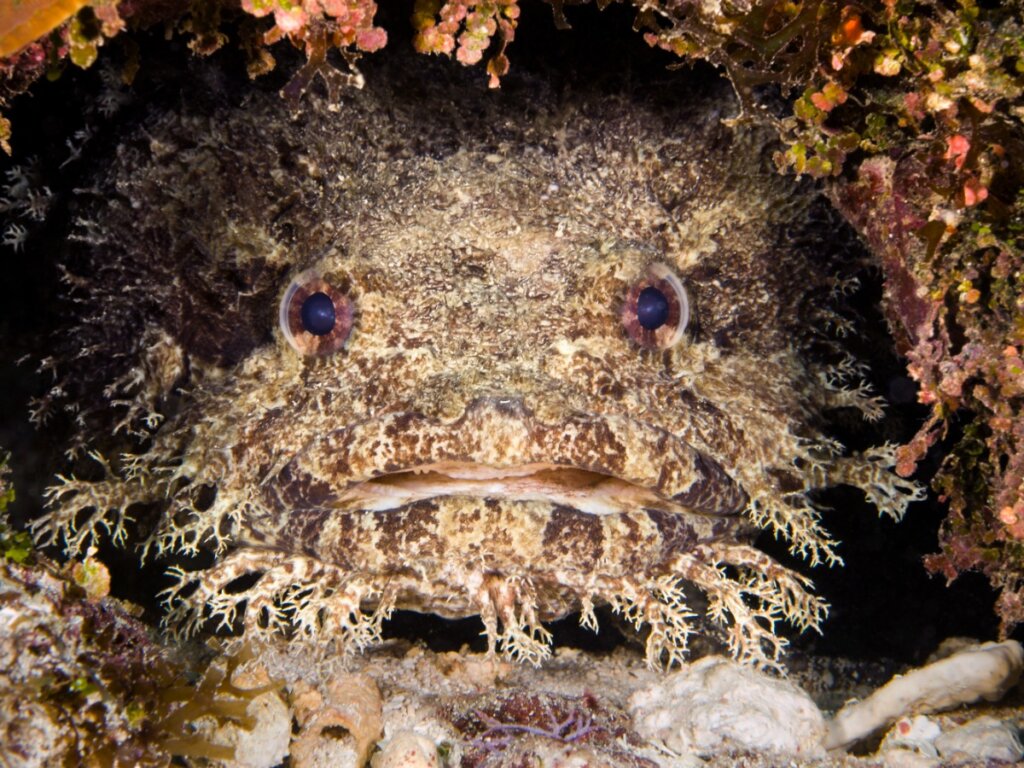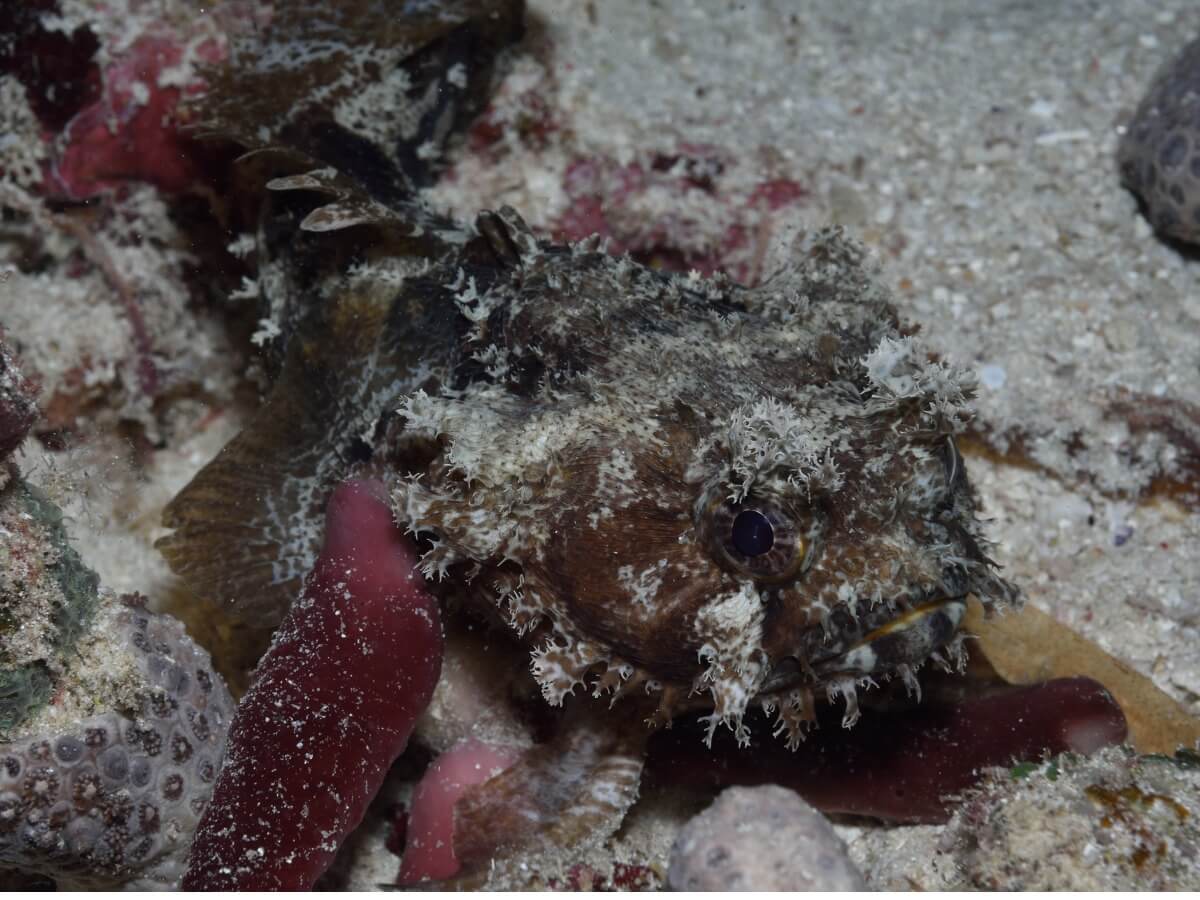Toadfish: Habitat and Characteristics

The term toadfish doesn’t refer to a single species of animal within the actinopterygian class. Rather, it encompasses the species that belong to the Batrachoididae family, which, in turn, belong to the order Batrachoidiformes. This group includes a total of 83 species, in turn divided into 21 different genera. All of them have certain common characteristics.
In this article, we’re going to focus on the Lusitanian toadfish (Halobatrachus didactylus). It’s the only member of its genus with an appearance similar to that of other more well-known representatives of the Batrachoididae family. If you’d like to know more about this species and its close relatives, keep reading!
Toadfish habitat
Toadfish, as a family, live all over the planet. Most of the species included in this taxon are marine, although many of them live in intermediate saline waters. The exception to the rule is the Thalassophryninae subfamily. This has representatives that only inhabit the fresh waters in South American rivers, especially the Amazon.
For its part, the Lusitanian toadfish (Halobatrachus didactylus) extends throughout the eastern Atlantic Ocean —from Portugal to Ghana— and the Mediterranean. It has also been introduced in the northern part of Spain due to natural movements, probably due to the warming of the waters. The Galician town hall (in Spain) says that the first sighting in this region dates from 2018.
This fish lives at a shallow depth – up to 100 meters (330 feet) from the surface, but normally between 10 and 50 meters (33 to 165 feet), on sandy and rocky bottoms. As we’ll see, its coloration allows the animal to completely blend in with the typical environment at the bottom of the Mediterranean waters.
There are many species of toadfish, distributed in almost all the seas of the world.

Physical characteristics
In general, toadfish don’t have scales and have large, flattened heads. Their mouths are also very prominent, with highly developed maxillae and premaxilla. Appendages or barbels usually hang from the lower region of the mouth. These are sensory organs that help these animals locate food in murky waters where vision doesn’t help.
In addition, the gills are small and lateralized. These fish also have pectoral and pelvic fins, which, in turn, are supported by spines and various soft rays. For its part, the Lusitanian toadfish has two spines covered with skin in the upper corner of the operculum and two dorsal fins.
The first of these dorsal fins has three strong covered spines, while the second is supported by 19-24 long, smooth rays. The skin doesn’t have any scales – like other toadfish – and is covered by a characteristic mucus. Its color is light brown with dark spots that form patterns and its maximum size is 55 centimeters (21 inches).
This tonality allows the toadfish to blend in with the tones of the seabed, be it rocks or sand.
The behavior of the Lusitanian toadfish
The Lusitanian toadfish is a sedentary animal that’s normally found in substrates formed by sand, rocks, and mud. In addition to its cryptic tone, this fish remains partially buried at the bottom of the sea most of the time, only exposing its most prominent fins and head region. In this position, it waits for its prey to pass in front of it.
Fish capable of making sounds
Beyond its habits with respect to its environment, this fish stands out above the rest for its ability to perform vocalizations. According to studies published on the scientific portal FISH Biology, the sounds emitted vary according to the time of year. During mating, males make hissing-type sounds, while other vocal registers appear year-round.
Experts believe this behavior isn’t present in the earliest stages of development. The emission of sounds seems to begin when the juveniles are capable of generating grunts with a higher sound level and a lower dominant frequency.
Experts believe that the speech capacity in this species has arisen in order to attract females or warn other males of the limits of the territories. This trait is of great scientific interest.
Feeding
The toadfish is a solitary animal and remains partially buried or hides in the crevices of the stones most of its life. It feeds mainly on mollusks, crustaceans, and other small fish, which is why it’s considered a predatory species. Its strategy is of the sit and wait type. It simply waits for the victim to wander by and then devours it with its large head apparatus.
This fish isn’t very important in the fish trade for food purposes, and these animals aren’t usually consumed.
As it doesn’t have teeth, this species consumes its prey whole, without chewing it up first.
Reproduction of toadfish
According to a study published in the scientific journal General and Comparative Endocrinology, this species has a reproductive cycle that spans from March to August. There is a peak between May and June. During this time, males produce special vocalizations, thanks to the use and contraction of their swim bladder. These serve to attract females or to avoid conflicts with other males.
Receptive males attract females to their nests or places of residence. If these have been “convinced” by the vocalizations, they will release the eggs to the outside, where external fertilization takes place. These eggs are sticky on one side and adhere perfectly to the male’s nest. This will protect them until they hatch.

State of conservation and final notes
As indicated by the International Union for Conservation of Nature (IUCN), this species is considered of least concern as far as conservation is concerned. Some populations are established in protected areas and aren’t exploited for consumption in the market. As a result, there are no real dangers that could threaten them in this sense.
If there’s one thing that stands out above many other species, it’s the ability of the Lusitanian toadfish to produce vocalizations during their mating season and at other times too. This ability has greatly attracted the interest of scientists and the general public alike.
All cited sources were thoroughly reviewed by our team to ensure their quality, reliability, currency, and validity. The bibliography of this article was considered reliable and of academic or scientific accuracy.
- Halobatrachus didactylus, Redogal. Recogido a 21 de junio en https://redogal.xunta.gal/es/guia-especies/halobatrachus-didactylus
- Amorim, M. C. P., Vasconcelos, R. O., Marques, J. F., & Almada, F. (2006). Seasonal variation of sound production in the Lusitanian toadfish Halobatrachus didactylus. Journal of Fish Biology, 69(6), 1892-1899.
